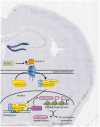Activin Signaling in the Pathogenesis and Therapy of Neuropsychiatric Diseases
- PMID: 27242425
- PMCID: PMC4861723
- DOI: 10.3389/fnmol.2016.00032
Activin Signaling in the Pathogenesis and Therapy of Neuropsychiatric Diseases
Abstract
Activins are members of the transforming growth factor β (TGFβ) family and serve as multifunctional regulatory proteins in many tissues and organs. In the brain, activin A, which is formed by two disulfide-linked βA subunits, is recognized as the predominant player in activin signaling. Over the last years, considerable progress has been made in elucidating novel and unexpected functions of activin in the normal and diseased brain and in deciphering the underlying molecular mechanisms. Initially identified as a neurotrophic and protective factor during development and in several forms of acute injury, the scope of effects of activin A in the adult central nervous system (CNS) has been considerably broadened by now. Here, we will highlight recent findings that bear significance for a better understanding of the pathogenesis of various neuropsychiatric diseases and might hold promise for novel therapeutic strategies. While the basal level of activin A in the adult brain is low, significant short-term up-regulation occurs in response to increased neuronal activity. In fact, brief exposure to an enriched environment (EE) is already sufficient to considerably strengthen activin signaling. Enhancement of this pathway tunes the performance of glutamatergic and GABAergic synapses in a fashion that impacts on cognitive functions and affective behavior, counteracts death-inducing signals through extrasynaptic NMDA receptors (NMDARs), and stimulates adult neurogenesis in the hippocampus. We will discuss how impaired activin signaling is involved in anxiety disorders, depression, drug dependence, and neurodegenerative diseases such as Alzheimer's and Parkinson's, and how reinforcement of activin signaling might be exploited for therapeutic interventions.
Keywords: activin; anxiety disorders; depression; drug craving; neurodegenerative disease.
Figures


Similar articles
-
Activin tunes GABAergic neurotransmission and modulates anxiety-like behavior.Mol Psychiatry. 2009 Mar;14(3):332-46. doi: 10.1038/sj.mp.4002131. Epub 2008 Jan 8. Mol Psychiatry. 2009. PMID: 18180762
-
More than being protective: functional roles for TGF-β/activin signaling pathways at central synapses.Trends Neurosci. 2011 Aug;34(8):421-9. doi: 10.1016/j.tins.2011.06.002. Trends Neurosci. 2011. PMID: 21742388 Review.
-
Kdm6b and Pmepa1 as Targets of Bioelectrically and Behaviorally Induced Activin A Signaling.Mol Neurobiol. 2016 Aug;53(6):4210-4225. doi: 10.1007/s12035-015-9363-3. Epub 2015 Jul 28. Mol Neurobiol. 2016. PMID: 26215835
-
Dorsal-Ventral Gradient of Activin Regulates Strength of GABAergic Inhibition along Longitudinal Axis of Mouse Hippocampus in an Activity-Dependent Fashion.Int J Mol Sci. 2023 Aug 24;24(17):13145. doi: 10.3390/ijms241713145. Int J Mol Sci. 2023. PMID: 37685952 Free PMC article.
-
Activins in reproductive biology and beyond.Hum Reprod Update. 2016 Apr;22(3):342-57. doi: 10.1093/humupd/dmv058. Epub 2016 Feb 15. Hum Reprod Update. 2016. PMID: 26884470 Review.
Cited by
-
Non-coding RNAs involved in the molecular pathology of Alzheimer's disease: a systematic review.Front Neurosci. 2024 Jun 28;18:1421675. doi: 10.3389/fnins.2024.1421675. eCollection 2024. Front Neurosci. 2024. PMID: 39005845 Free PMC article.
-
Identification and characterization of noncoding RNAs-associated competing endogenous RNA networks in major depressive disorder.World J Psychiatry. 2023 Feb 19;13(2):36-49. doi: 10.5498/wjp.v13.i2.36. eCollection 2023 Feb 19. World J Psychiatry. 2023. PMID: 36925948 Free PMC article.
-
Dentate gyrus activin signaling mediates the antidepressant response.Transl Psychiatry. 2021 Jan 7;11(1):7. doi: 10.1038/s41398-020-01156-y. Transl Psychiatry. 2021. PMID: 33414389 Free PMC article.
-
Rlip76: An Unexplored Player in Neurodegeneration and Alzheimer's Disease?Int J Mol Sci. 2022 May 29;23(11):6098. doi: 10.3390/ijms23116098. Int J Mol Sci. 2022. PMID: 35682775 Free PMC article. Review.
-
Peptide-Based Scaffolds for the Culture and Transplantation of Human Dopaminergic Neurons.Tissue Eng Part A. 2020 Feb;26(3-4):193-205. doi: 10.1089/ten.TEA.2019.0094. Epub 2019 Oct 17. Tissue Eng Part A. 2020. PMID: 31537172 Free PMC article.
References
Publication types
LinkOut - more resources
Full Text Sources
Other Literature Sources

